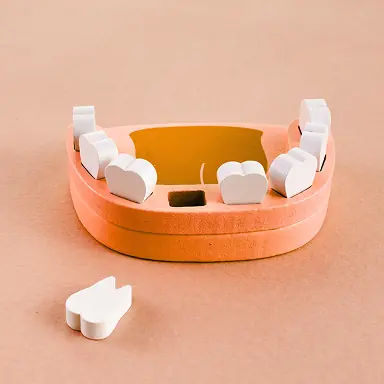
In addition to dental school, pediatric dentists complete an extra two to three years of advanced training focused entirely on infants, children, adolescents, and those with special health needs.
Aside from being skilled in clinical care, they have experience in managing behavior, easing anxiety, and creating a positive dental experience tailored to each developmental stage.
Both the American Academy of Pediatric Dentistry and the American Dental Association recommend scheduling the first dental appointment around your child’s first birthday, or within six months after the first tooth appears.
Children often take their emotional cues from the adults around them. Speaking positively about the dental visit and avoiding words that might cause fear can go a long way.
You might also explore children’s books or short videos that show friendly dental visits in action. Role-playing at home—like pretending to brush a stuffed animal’s teeth or using a mirror to look inside their mouth—can also make the experience more familiar.
Bringing a favorite stuffed animal or small comfort item to the appointment is always encouraged. We’ll do our part to help your child feel secure and welcome.
Absolutely! Parents are always welcome to accompany their child during dental checkups and cleanings. We find that having a familiar face nearby often helps kids feel more at ease.
Even before the first tooth appears, you can gently wipe your baby’s gums with a clean, damp cloth. Once teeth come in, brushing twice a day for two minutes with a soft-bristled brush is the standard.
The most important time to brush is before bedtime. Make sure to supervise brushing until your child can reliably spit and rinse on their own, usually around age 6 to 8.
As soon as two teeth begin to touch, it’s time to start flossing. While some young children naturally have spacing between their teeth, others don’t—and in those tighter spots, flossing helps remove food debris and plaque that brushing alone can miss.
Nightly flossing is ideal for preventing cavities and keeping the gums healthy.
Toothpaste use should begin with the first tooth. For children under age 3, we recommend hydroxyapatite toothpaste, which is safe to swallow and effective at protecting enamel.
After age 3, a pea-sized amount of fluoridated toothpaste may be used under your supervision, unless you choose to continue with a hydroxyapatite option. Always encourage spitting and rinsing.
In many cases, yes. Sealants are strongly recommended for most children once their permanent molars come in. These teeth have deep grooves that can be hard to clean thoroughly with a toothbrush, making them more vulnerable to cavities.
Applying sealants is a simple, painless way to provide extra protection during the years when children are most prone to decay. If your child has a history of cavities, deep grooves in their teeth, or difficulty keeping molars clean, sealants may be especially beneficial.
Pacifiers can be soothing, but prolonged use may begin to impact how teeth grow in. Extended use beyond toddlerhood can cause bite changes, such as an open bite where the front teeth don’t meet properly or a crossbite due to narrowing of the upper jaw.
It may also encourage tongue positioning habits that affect speech development. If you have concerns, we’re happy to talk through strategies for weaning and keeping oral development on track.








